Tag: CFA
-
Nation & World
Planet starship
Seven years ago, astronomers boggled when they found the first runaway star flying out of our galaxy at a speed of 1.5 million miles per hour. The discovery intrigued theorists, who wondered: If a star can get tossed outward at such an extreme velocity, could the same thing happen to planets? New research shows that…
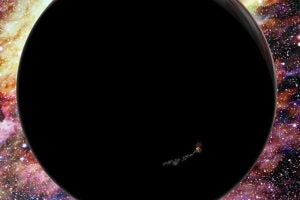
-
Nation & World
In distant space, a water world
Observations by NASA’s Hubble Space Telescope have added a new type of planet to the mix. By analyzing the previously discovered world GJ1214b, astronomer Zachory Berta of the Harvard-Smithsonian Center for Astrophysics and colleagues proved that it is a water world enshrouded by a thick, steamy atmosphere.
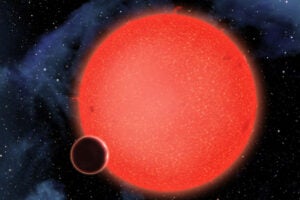
-
Nation & World
Black hole came from shredded galaxy
Astronomers using NASA’s Hubble Space Telescope have found a cluster of young, blue stars encircling the first intermediate-mass black hole ever discovered. The presence of the star cluster suggests that the black hole was once at the core of a now-disintegrated dwarf galaxy.
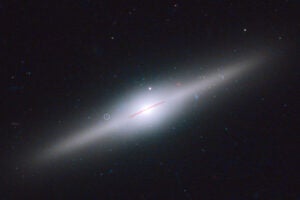
-
Nation & World
Alien worlds, just like home
Harvard astronomers, working as part of NASA’s Kepler mission, have detected the first Earth-sized planets orbiting a distant star, a milestone in the hunt for alien worlds that brings scientists one step closer to their ultimate goal of finding a twin Earth.
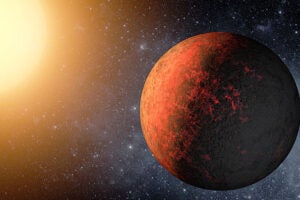
-
Nation & World
Powerful telescope has scientists seeing red
In the distant reaches of the universe, almost 13 billion light-years from Earth, a strange species of galaxy lay hidden. Cloaked in dust and dimmed by the intervening distance, even the Hubble Space Telescope couldn’t spy it. It took the revealing power of NASA’s Spitzer Space Telescope to uncover not one, but four remarkably red…
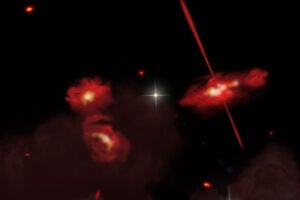
-
Nation & World
Bright idea
In a new paper, Avi Loeb of the Harvard-Smithsonian Center for Astrophysics and Edwin Turner of Princeton University suggest a new technique for finding aliens: Look for their city lights.
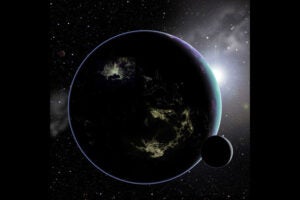
-
Nation & World
New views of the cosmos
Though it won’t be completed until 2013, the Atacama Large Millimeter/submillimeter Array, a radio telescope observatory under construction in northern Chile, is already the most powerful and complex such facility ever built, and four astronomers from the Harvard-Smithsonian Center for Astrophysics are among those first in line to use it.
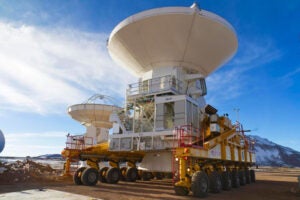
-
Nation & World
Nobel origins
All three winners of the 2011 Nobel Prize in physics have connections to Harvard — including two whose Ph.D.s launched them into their winning notion of an accelerating universe and the puzzle of dark matter.
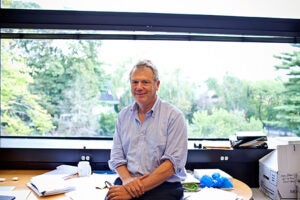
-
Nation & World
Scientific research, artfully shown
Researchers at the Harvard-Smithsonian Center for Astrophysics have embarked on an exploration unusual for space scientists — one involving art. A project probes how the presentation of images of space affects viewers’ appreciation and understanding of what’s happening in the pictures.
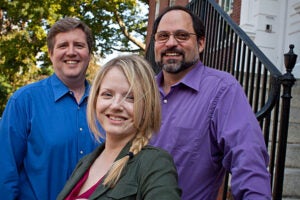
-
Nation & World
When old stars slow down
New research from the Harvard-Smithsonian Center for Astrophysics shows that some old stars might be held up by their rapid spins, and when they slow down, they explode as supernovae. Thousands of these “time bombs” could be scattered throughout our Galaxy.
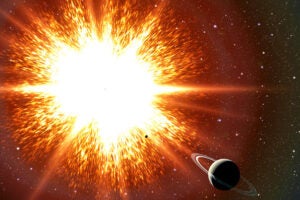
-
Nation & World
Alien world is blacker than coal
Imagine a giant world like Jupiter, but more alien than any planet in our solar system. Instead of displaying gleaming clouds colored white and salmon, this world is darker than the blackest lump of coal. It glows only with a feeble red light like a stove’s electric burner — the result of scorching heat from…
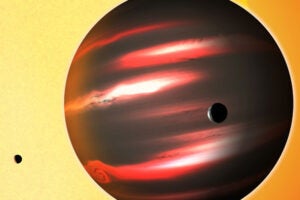
-
Nation & World
Light fantastic
New research shows that aurorae on distant “hot Jupiters” could be 100 to 1,000 times brighter than Earth’s aurorae. “I’d love to get a reservation on a tour to see these aurorae,” said lead author Ofer Cohen, a postdoctoral fellow at the Harvard-Smithsonian Center for Astrophysics.
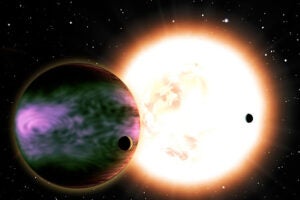
-
Nation & World
‘It is within our grasp’
Answers to questions about life in the universe is “within our grasp,” astronomer Lisa Kaltenegger said at an Origins of Life Initiative forum.
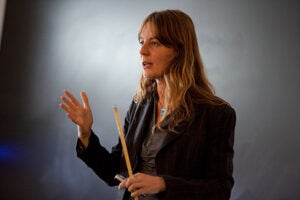
-
Nation & World
Forward, into the past
Harvard undergraduate Derek Robins recounts his summer spent doing astronomy research on campus.

-
Nation & World
‘Black Holes’ at the Museum of Science
The exhibition “Black Holes: Space Warps & Time Twists,” produced by the Harvard-Smithsonian Center for Astrophysics, will open at the Boston Museum of Science on June 21. The exhibit journeys to the edge of black holes to discover how recent scientific research is challenging notions of space and time, and, in the process, turning science…
-
Nation & World
Kepler starts search for other Earths
As NASA’s Kepler space telescope this week begins scanning the Milky Way for planets that might harbor life, scientists at the Harvard-Smithsonian Center for Astrophysics (CfA) are keeping their fingers crossed and waiting for the data to start flowing.
-
Nation & World
Life in the universe? Almost certainly. Intelligence? Maybe not
We are likely not alone in the universe, though it may feel like it, since life on other planets is probably dominated by microbes or other nonspeaking creatures, according to scientists who gave their take on extraterrestrial life at Harvard last week.
-
Nation & World
Astronomy Department dedicates new telescope
A small knot of a dozen people gathered on the Science Center roof on Friday (Oct. 31) to officially dedicate Harvard’s latest teaching telescope, a 16-inch cassegrain telescope built by DFM Engineering in Colorado.
-
Nation & World
Solar system’s twin has two asteroid belts
Astronomers have discovered that the nearby star Epsilon Eridani has two rocky asteroid belts and an outer icy ring, making it a triple-ring system. The inner asteroid belt is a virtual twin of the belt in our solar system, while the outer asteroid belt holds 20 times more material. Moreover, the presence of these three…
-
Nation & World
Black holes are the heart of galaxies
Astronomers think that many — perhaps all — galaxies in the universe contain massive black holes at their centers. New observations with the Submillimeter Array now suggest that such colossal black holes were common even 12 billion years ago, when the universe was only 1.7 billion years old and galaxies were just beginning to form.…
-
Nation & World
Star quest knowledge provides new view of ourselves
In a basement laboratory at the Harvard-Smithsonian Center for Astrophysics (CfA), surrounded by instruments built to detect the universe’s distant secrets, sits a machine that will help us look not outward to the stars, but inward at our own bodies.
-
Nation & World
J. Richard Bond awarded Gruber Prize at CfA
Theoretical work on the evolution and structure of the universe landed Canadian cosmologist J. Richard Bond the 2008 Cosmology Prize of the Peter and Patricia Gruber Foundation, awarded Sept. 17 at the Harvard-Smithsonian Center for Astrophysics (CfA).
-
Nation & World
CfA to host focus group on aesthetics and astronomy
The Harvard-Smithsonian Center for Astrophysics (CfA) is sponsoring a focus group survey on Dec. 3 at Phillips Auditorium, 60 Garden St., to gather information on how NASA scientists create astronomical imagery. CfA experts will be on hand for the 3 p.m. talk and discussion. Astronomy enthusiasts are invited to register for the survey, which will…
-
Nation & World
Publications recognize three CfA astronomers
Three astronomers at the Harvard-Smithsonian Center for Astrophysics (CfA) were recently recognized for their innovative work by three leading national magazines. The trio was selected from hundreds of scientists across the country for their leadership and achievements in their respective research fields.
-
Nation & World
White dwarf ‘sibling rivalry’ explodes into supernova
Astronomers at the Harvard-Smithsonian Center for Astrophysics (CfA) have found that a supernova discovered last year was caused by two colliding white dwarf stars.
-
Nation & World
Massive black hole smashes record for sizeMassive black hole smashes record for size
Using two NASA satellites, astronomers have discovered a black hole that obliterates a record announced just two weeks ago. The new black hole, with a mass 24 to 33 times that of our sun, is the heftiest known black hole to orbit another star.
-
Nation & World
Harvard brings the Earth to high school
Steam vents in Yellowstone National Park are part of the area’s unique environment, seen in a case study exploring Yellowstone and the reintroduction of wolves into the park. This case study is part of a new environmental science course for high school science teachers.
-
Nation & World
CfA reveals Magellanic Clouds are first-time visitors
The Large Magellanic Cloud (LMC) and Small Magellanic Cloud (SMC) are two of the Milky Way’s closest neighboring galaxies. A stunning sight in the southern hemisphere, they were named after the Portuguese explorer Ferdinand Magellan, who explored those waters in the 16th century. For hundreds of years, these galaxies were considered satellites of the Milky…


